THE MENOMONEE FALLS GAZETTE
Volume 4 Number 186
July 7, 1975
LET'S VISIT RUSS MANNING
(An Interview with Russ Manning)
by Shel Dorf
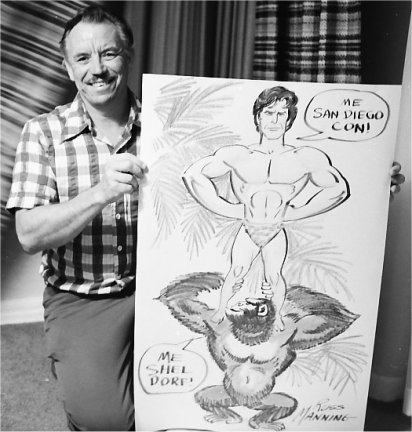 DORF:
As we approach the 100th celebration of Edgar Rice Burroughs' birth, what
are your thoughts concerning the various media which has handled the Burroughs
books? (Books, films, comic strips and books, TV) Which have been the most
successful in terms of popularity? Which have been the least popular with
t he Burroughs purists?
DORF:
As we approach the 100th celebration of Edgar Rice Burroughs' birth, what
are your thoughts concerning the various media which has handled the Burroughs
books? (Books, films, comic strips and books, TV) Which have been the most
successful in terms of popularity? Which have been the least popular with
t he Burroughs purists?
MANNING: My first remembered exposure, at 10 years or
so old, to Edgar Rice Burroughs was a "Tarzan Big-Little Book: "The Beasts
of Tarzan." The same strange shudder goes through me today when I re-read
where the crocodile pulls Tarzan down into the water and to its lair beneath
the river bank. That croc and what it tried to do to Tarzan had to
be one of the most shocking, unimaginably horrible things that could come
on a pre-teen small town boy! Especially a boy in a town so small it did
not have a movie theatre, and wouldn't know its first TV set for another
ten or twelve years. I soon found the Tarzan novels in the county library
and read all they had, of course; and eventually discovered Hogarth's Tarzan
in the Sunday L.A. TIMES. It wasn't until much later that I saw a Tarzan
movie (unimpressed), Jesse Marsh's Dell comic books (bought them all) .
. . and I have yet to see a single episode of the Tarzan TV series. Based
on the foregoing exposure, I feel that the first dozen books written by
ERB himself off the COMPLETE Tarzan WHOLE . . . no one since, in
whatever medium, has added one single iota to the person, character, milieu,
whatever. . . of the folk-hero ERB conceived. Foster's heroic homo sapiens,
Weissmuller's superb primitive athlete (1st two movies), Hogarth's monolithic
machine, St. John's romantic vision, Frazetta's rank savage. . . my own
version. . . are all no more than variations on a theme.
If we Burroughs purists rank ERB's early novels as the
finest Tarzans, then the work of certain of my fellow graphic story creators
must rank as the poorest. . . lower even than the last, fattest Johnny
W's! But sixty years have passed since the ape-man was whelped on that
lonely African coast, and Tarzan is very much with us. . . even, at this
moment, once more surging in popularity. The entire world knows and
NEEDS this supremely capable man.
DORF: When did you first decide to follow a career as
a cartoonist? Who was your inspiration, and what was your early training?
MANNING: The moment of decision may have been when I decided,
after two years, to drop out of college; to no longer worry about having
teacher's credentials in case I needed something to fall back on.
To be honest, I really don't know. . . sometimes I suspect that I reach
important decisions by osmosis. I have always drawn, of course, and
being the "best" artist in high school tilted me toward a career in art.
. . as opposed to music, say, where several classmates outblew me. I found
out in art school and college that I wasn't fad/chic-oriented enough to
make it in advertising art. . . and I was still buying comic books long
after my buddies had switched to beer.
DORF: What was your first sale? Can you recall the first
rejections of your work, and what motivated you to keep trying?
MANNING: First sale? In high school I won a California-wide
contest to design the Bus of the Future. . . paid me $100.00. Tom
McKimson, West coast art director for Dell Comic Book, turned me down three
times in six months and hired me the fourth trip. I kept going back because
I was convinced he was mistaken. Later, he said that he wanted to know
if I REALLY WANTED to draw comic books.
DORF: What types of jobs did you have to take until cartooning
and illustrating took over on a full time basis?
MANNING: Nothing to speak of. . . just jobs while I was
going to school. Comic book illustration (with a comic strip as ultimate
goal) was the only career I ever put all my energy toward.
DORF: Have you taken any writing classes? Do you read
much science-fiction?
MANNING: No writing class, to my possible sorrow. I was
very heavy into science-fiction during the '40s and early '50s . . . very
little now, except for anything by Andre Norton, and DUNE once a year.
I wonder if we would still buy comic books if we weren't in the graphic
story field, but certain comics still seem worth buying, if only for the
artwork. Anything by Barry Smith, Corben and Crumb. . . most of Toth, Redondo
and Giraud. The genius of Jack Kirby is recognized and admired, but
I don't buy comic books for the things that Jack puts into them. I am NOT
an admirer of the current style of comic book OVER-writing.
DORF: Can you estimate how many people you reach with
your Tarzan newspaper strip?
MANNING: How about one-tenth of those who read it?
DORF: Does audience reaction influence your writing?
MANNING: Sure! There seems to be almost complete
acceptance of whatever it is I'm doing, so I'll continue to do it.
DORF: Do you write out a complete continuity before each
story, or do you adlib as the story progresses?
Also, what excites you most and is the most fun as you
get behind the drawing board each morning?
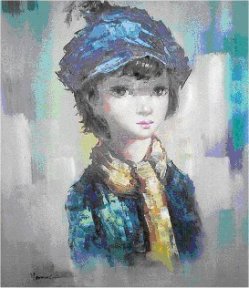 MANNING:
I know in broad generalities where each episode of the Sunday page will
go and achieve along the way, but I do not write ahead of each page. The
chance to wing it as you go, increasing the possibility of unexpected tension
and accidents, is one of the joys of creating a comic strip. But the 46
page Tarzan albums are a whole 'nother bucket of worms! I've just finished
number four, and I've had to do some pioneering in this format, since these
Tarzan books are among the very first of a new breed. 46 pages is LONG
. . . much too long to handle like a 15-20 page comic book story, and certainly
not like a sometimes meandering comic strip. A good album must be carefully
crafted, with definite pacing of story line, information, density, characterizations,
and where possible, even color. I'm still learning about this format,
of course. . . but the way I'm handling them seems to have evolved into
something closer to movie-making than to any of the usual methods of comic
book / strip creation. I block out a rather complete plot and page breakdown,
then begin writing and illustrating anywhere I feel like it throughout
the 46 pages. If, in writing and illustrating a certain sequence, I feel
it needs emphasis, it gets more pages than shown on the story board, .
. . realizing, of course, that there must be a corresponding reduction
elsewhere. Then, as completion nears, and even AFTER completion, it becomes
necessary to edit. And, I must admit, there have been out-takes. . . on
the studio floor. . . panels, pages, that didn't fit or were too irrelevant.
Wasteful, perhaps, but this method allows the maximum freedom to create.
These albums are very exciting to do. . . they're a real challenge, trying
to realize the potential inherent in this, the next logical step for class
graphic stories.
MANNING:
I know in broad generalities where each episode of the Sunday page will
go and achieve along the way, but I do not write ahead of each page. The
chance to wing it as you go, increasing the possibility of unexpected tension
and accidents, is one of the joys of creating a comic strip. But the 46
page Tarzan albums are a whole 'nother bucket of worms! I've just finished
number four, and I've had to do some pioneering in this format, since these
Tarzan books are among the very first of a new breed. 46 pages is LONG
. . . much too long to handle like a 15-20 page comic book story, and certainly
not like a sometimes meandering comic strip. A good album must be carefully
crafted, with definite pacing of story line, information, density, characterizations,
and where possible, even color. I'm still learning about this format,
of course. . . but the way I'm handling them seems to have evolved into
something closer to movie-making than to any of the usual methods of comic
book / strip creation. I block out a rather complete plot and page breakdown,
then begin writing and illustrating anywhere I feel like it throughout
the 46 pages. If, in writing and illustrating a certain sequence, I feel
it needs emphasis, it gets more pages than shown on the story board, .
. . realizing, of course, that there must be a corresponding reduction
elsewhere. Then, as completion nears, and even AFTER completion, it becomes
necessary to edit. And, I must admit, there have been out-takes. . . on
the studio floor. . . panels, pages, that didn't fit or were too irrelevant.
Wasteful, perhaps, but this method allows the maximum freedom to create.
These albums are very exciting to do. . . they're a real challenge, trying
to realize the potential inherent in this, the next logical step for class
graphic stories.
DORF: What do you do for relaxation away from the board?
Hobbies?
MANNING: I'm quite involved in civic affairs of our small
mountain community; and ours is a family that gets involved in each other's
interests and activities.
DORF: How many characters have you personally created,
and which are the most popular?
MANNING: Tough, irascible little Joiper, the ant man warrior,
is the character I've created that gets the most requests to bring back
whenever he is absent from the page.
DORF: Have you been well received by European comic buffs?
How do their publications differ from ours?
MANNING: I surely can't complain about ANY reception my
version of Tarzan has had (except by the person doing the DC comic book
adaptation). It was the very impressive European hard-cover, fine paper,
beautifully printed well written and illustrated albums that inspired our
Tarzan albums. . . and, incidentally, are well on the way to revolutionizing
ALL comic books, including those in this country.
DORF: Does it bother you that the top panels are left
out when your Sunday Tarzan page is used as a one-third page? Why don't
you follow Milton Caniff's layout? His mot complete page is the one-third
size.
MANNING: No, it doesn't seem to bother me. . . maybe a
case of never missing what you never had. . . but I don't believe Caniff's
format would work as well for me as the UFS layout. As often as my story
allows, I like to use odd-sized panels, dropped borders, and intermeshed
vignettes. . . difficult to crop, as every panel must be cropped for the
half and tabloid pages in the Caniff format. Nor would I relish having
my big splash panels cropped. So I have fun with the top two panels, and
give the papers astute enough to carry them a little extra in the way of
action or girls or story.
DORF: Do you see the need for better treatment
of newspaper comics by local editors?
MANNING: It seems to me that all of the popular comic
strips are treated as well as most editors can afford to do so. . . EXCEPT
by those foolish few who cram more than three Sunday strips on one page.
. . and print dailies only four columns wide. In all probability, the bad-mouthing
of adventure strips was deserved, up to just recently. But not NOW! Look
at most papers. The bland, insipid, realy-dull adventure strips are almost
all gone. There's a new crop of well-written, exciting adventure stories
(including a couple old-timers that have always been top-notch and popular).
. . and I look for the public and editors to begin realizing it.
DORF: Would you enjoy scripting a Tarzan television show?
Have you had any offers? Many of the fans I've spoken to think your stories
would make a most exciting television series.
MANNING: The chance to try anything and everything
in my field of interest and ability sounds great. But seeing my own work
reproduced as much as possible as I created it seems to be a very strong
part of me. . . and TV's emasculations are not appealing. In fact, TV doesn't
appeal to us at all. . . not since 1962 when we threw the set in
the garbage pail.
DORF: Any personal beefs about the comic strip industry?
What do you most enjoy about your job?
MANNING: I have heard one comment, allegedly from newspaper
editors, including the comic strip editor for the Los Angeles TIMES, that
disturbs me, because of its biased, let-someone-else-think lack of logic.
The comment: that buying the Tarzan comic strip might antagonize black
people. I won't discuss, here, whether the Tarzan of ERB's books, or the
movies, comic books, or past comic strips might have been distasteful to
blacks. . . but if those bigoted editors mentioned above would read the
Tarzan comic strip since 1967, they would discover that ALL blacks therein
are HUMAN BEINGS, distinguishable from the other races of humanity by their
color and physiognomy. . . but INDISTINGUISHABLE from any other human as
to heroic or dastardly characteristics, or as to their ability to handle
their own affairs with or without Tarzan. It may be as stupid to reject
the 1975 Tarzan because of attitudes of the past as if would be to throw
out Blondie, Steve Canyon, Peanuts, Prince Valiant, Rick O'Shay, etc.,
because those strips rarely even show a black person, let alone one in
a stellar role.
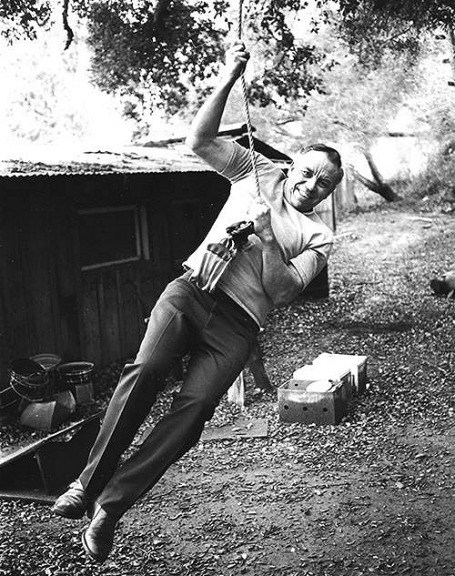

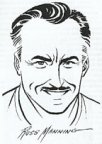

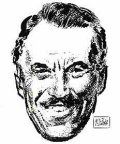
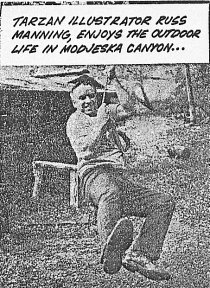
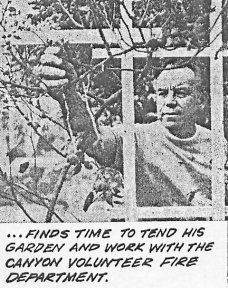
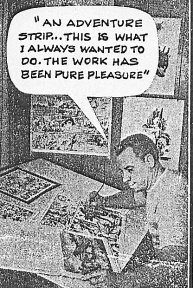
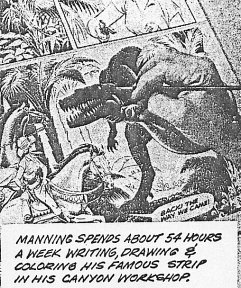
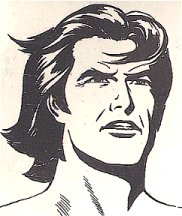
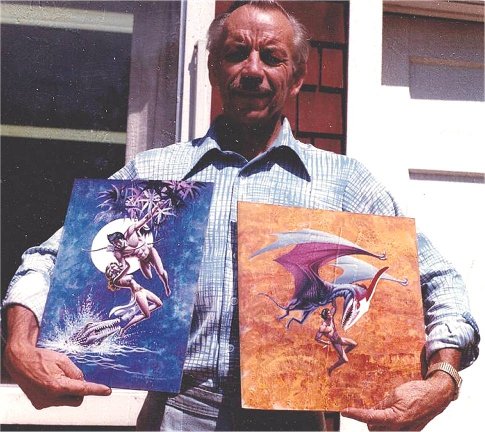
 DORF:
As we approach the 100th celebration of Edgar Rice Burroughs' birth, what
are your thoughts concerning the various media which has handled the Burroughs
books? (Books, films, comic strips and books, TV) Which have been the most
successful in terms of popularity? Which have been the least popular with
t he Burroughs purists?
DORF:
As we approach the 100th celebration of Edgar Rice Burroughs' birth, what
are your thoughts concerning the various media which has handled the Burroughs
books? (Books, films, comic strips and books, TV) Which have been the most
successful in terms of popularity? Which have been the least popular with
t he Burroughs purists?
 MANNING:
I know in broad generalities where each episode of the Sunday page will
go and achieve along the way, but I do not write ahead of each page. The
chance to wing it as you go, increasing the possibility of unexpected tension
and accidents, is one of the joys of creating a comic strip. But the 46
page Tarzan albums are a whole 'nother bucket of worms! I've just finished
number four, and I've had to do some pioneering in this format, since these
Tarzan books are among the very first of a new breed. 46 pages is LONG
. . . much too long to handle like a 15-20 page comic book story, and certainly
not like a sometimes meandering comic strip. A good album must be carefully
crafted, with definite pacing of story line, information, density, characterizations,
and where possible, even color. I'm still learning about this format,
of course. . . but the way I'm handling them seems to have evolved into
something closer to movie-making than to any of the usual methods of comic
book / strip creation. I block out a rather complete plot and page breakdown,
then begin writing and illustrating anywhere I feel like it throughout
the 46 pages. If, in writing and illustrating a certain sequence, I feel
it needs emphasis, it gets more pages than shown on the story board, .
. . realizing, of course, that there must be a corresponding reduction
elsewhere. Then, as completion nears, and even AFTER completion, it becomes
necessary to edit. And, I must admit, there have been out-takes. . . on
the studio floor. . . panels, pages, that didn't fit or were too irrelevant.
Wasteful, perhaps, but this method allows the maximum freedom to create.
These albums are very exciting to do. . . they're a real challenge, trying
to realize the potential inherent in this, the next logical step for class
graphic stories.
MANNING:
I know in broad generalities where each episode of the Sunday page will
go and achieve along the way, but I do not write ahead of each page. The
chance to wing it as you go, increasing the possibility of unexpected tension
and accidents, is one of the joys of creating a comic strip. But the 46
page Tarzan albums are a whole 'nother bucket of worms! I've just finished
number four, and I've had to do some pioneering in this format, since these
Tarzan books are among the very first of a new breed. 46 pages is LONG
. . . much too long to handle like a 15-20 page comic book story, and certainly
not like a sometimes meandering comic strip. A good album must be carefully
crafted, with definite pacing of story line, information, density, characterizations,
and where possible, even color. I'm still learning about this format,
of course. . . but the way I'm handling them seems to have evolved into
something closer to movie-making than to any of the usual methods of comic
book / strip creation. I block out a rather complete plot and page breakdown,
then begin writing and illustrating anywhere I feel like it throughout
the 46 pages. If, in writing and illustrating a certain sequence, I feel
it needs emphasis, it gets more pages than shown on the story board, .
. . realizing, of course, that there must be a corresponding reduction
elsewhere. Then, as completion nears, and even AFTER completion, it becomes
necessary to edit. And, I must admit, there have been out-takes. . . on
the studio floor. . . panels, pages, that didn't fit or were too irrelevant.
Wasteful, perhaps, but this method allows the maximum freedom to create.
These albums are very exciting to do. . . they're a real challenge, trying
to realize the potential inherent in this, the next logical step for class
graphic stories.

